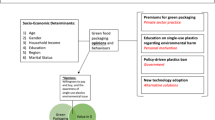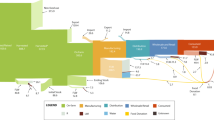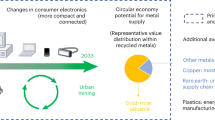Abstract
China has a rapidly growing online food delivery and takeaway market, serving 406 million customers with 10.0 billion orders and generating 323 kilotonnes of tableware and packaging waste in 2018. Here we use a top-down approach with city-level takeaway order data to explore the packaging waste and life-cycle environmental impacts of the takeaway industry in China. The ten most wasteful cities, with just 7% of the population, in terms of per capita waste generation, were responsible for 30% of the country’s takeaway waste, 27–34% of the country’s pollutant emissions and 30% of the country’s water consumption. We defined one paper substitution and two sharing tableware scenarios to simulate the environmental mitigation potentials. The results of the scenario simulations show that sharing tableware could reduce waste generation by up to 92%, and environmental emissions and water consumption by more than two-thirds. Such a mechanism provides a potential solution to address the food packaging waste dilemma and a new strategy for promoting sustainable and zero-waste lifestyles.
This is a preview of subscription content, access via your institution
Access options
Access Nature and 54 other Nature Portfolio journals
Get Nature+, our best-value online-access subscription
$29.99 / 30 days
cancel any time
Subscribe to this journal
Receive 12 digital issues and online access to articles
$119.00 per year
only $9.92 per issue
Buy this article
- Purchase on Springer Link
- Instant access to full article PDF
Prices may be subject to local taxes which are calculated during checkout





Similar content being viewed by others
Data availability
The weights of the tableware and packaging and cities’ takeaway order data are respectively provided in Supplementary Tables 1 and 5. The LCIs were sourced from manufacturers’ data, the CLCD56, Ecoinvent57 and literature sources59,60,69. All data used in the study are available from the corresponding author upon reasonable request. Source data are provided with this paper.
Code availability
All programming codes are available from the corresponding author upon reasonable request.
References
Hirschberg, C., Rajko, A., Schumacher, T. & Wrulich, M. The Changing Market for Food Delivery (McKinsey & Co., 2016).
Shedding Light on the ‘Meal-Sharing’ Platform Economy (Hotrec, 2018).
Maimaiti, M., Zhao, X. Y., Jia, M. H., Ru, Y. & Zhu, S. K. How we eat determines what we become: opportunities and challenges brought by food delivery industry in a changing world in China. Eur. J. Clin. Nutr. 72, 1282–1286 (2018).
China’s Catering Industry Development Report 2018 [in Chinese] (China Cuisine Association, Beijing, 2018).
Research Report on China Online Food Delivery Industry 2018–2019 [in Chinese] (iiMedia Research, 2019); https://www.iimedia.cn/c400/64223.html
Research Report on China Takeaway Development in 2017 [in Chinese] (Meituan Research Institute, 2018).
Jambeck, J. R. et al. Marine pollution. Plastic waste inputs from land into the ocean. Science 347, 768–771 (2015).
China’s food-delivery business is booming. So is waste. The Economist (19 October 2017).
Zheng, J. & Suh, S. Strategies to reduce the global carbon footprint of plastics. Nat. Clim. Change 9, 374–378 (2019).
Wang, A. N., Ma, X. C. & Zhang, C. 20 million takeaway orders per day lead to huge takeaway packaging waste. [in Chinese] Xinhuanet (21 September 2017); http://www.xinhuanet.com/mrdx/2017-09/21/c_136626055.htm
National Data (National Statistical Data Repository) (National Bureau of Statistics of China, 2019); http://data.stats.gov.cn
Annual Report on Prevention and Control of Environmental Pollution by Solid Waste in Chinese Large and Medium Cities in 2018 [in Chinese] (Ministry of Ecology and Environment of the People’s Republic of China, 2018).
Implementation Plan of Waste Sorting System [in Chinese] (General Office of State Council of the People’s Republic of China, 2017); http://www.gov.cn/zhengce/content/2017-03/30/content_5182124.htm
Work Plan for the Pilot Program of ‘Zero Waste Cities’ Construction [in Chinese] (General Office of State Council of the People’s Republic of China, 2019); http://www.gov.cn/zhengce/content/2019-01/21/content_5359620.htm
Opinion on Further Strengthening the Control of Plastic Pollution [in Chinese] (National Development and Reform Commission, Ministry of Ecology and Environment of the People’s Republic of China, 2020); http://www.mee.gov.cn/xxgk2018/xxgk/xxgk10/202001/t20200120_760495.html
Management Standards for Food Service (Internet) Take-Out of Paper Bowl and Food Delivered Bag [in Chinese] T/31SAFCM006-2018 (Shanghai Municipal Quality and Technical Supervision Bureau, 2018).
General Technical Requirements for Food Service (Internet) Take-Out of Paper Bowl [in Chinese] T/31SAFCM004-2018 (Shanghai Municipal Quality and Technical Supervision Bureau, 2018).
General Technical Requirements for Food Service (Internet) Take-Out of Food Delivered Bag [in Chinese] T/31SAFCM005-2018 (Shanghai Municipal Quality and Technical Supervision Bureau, 2018).
First Group Standards of Takeaway Containers Were Launched and Plastic Container Would Be Replaced by Paper One [in Chinese] (Shanghai Municipal People’s Government, 2018); http://www.shanghai.gov.cn/nw2/nw2314/nw2315/nw17239/nw17240/u21aw1306741.html
Shanghai Municipal Solid Waste Management Regulation [in Chinese] (Shanghai Municipal People’s Congress, 2019); http://www.spcsc.sh.cn/n1939/n1944/n1946/n2029/u1ai185433.html
Madival, S., Auras, R., Singh, S. P. & Narayan, R. Assessment of the environmental profile of PLA, PET and PS clamshell containers using LCA methodology. J. Clean. Prod. 17, 1183–1194 (2009).
Dormer, A., Finn, D. P., Ward, P. & Cullen, J. Carbon footprint analysis in plastics manufacturing. J. Clean. Prod. 51, 133–141 (2013).
Accorsi, R., Cascini, A., Cholette, S., Manzini, R. & Mora, C. Economic and environmental assessment of reusable plastic containers: a food catering supply chain case study. Int. J. Prod. Econ. 152, 88–101 (2014).
Leejarkpai, T., Mungcharoen, T. & Suwanmanee, U. Comparative assessment of global warming impact and eco-efficiency of PS (polystyrene), PET (polyethylene terephthalate) and PLA (polylactic acid) boxes. J. Clean. Prod. 125, 95–107 (2016).
Gallego-Schmid, A., Mendoza, J. M. F. & Azapagic, A. Improving the environmental sustainability of reusable food containers in Europe. Sci. Total Environ. 628–629, 979–989 (2018).
Gallego-Schmid, A., Mendoza, J. M. F. & Azapagic, A. Environmental impacts of takeaway food containers. J. Clean. Prod. 211, 417–427 (2019).
Cheroennet, N., Pongpinyopap, S., Leejarkpai, T. & Suwanmanee, U. A trade-off between carbon and water impacts in bio-based box production chains in Thailand: a case study of PS, PLAS, PLAS/starch, and PBS. J. Clean. Prod. 167, 987–1001 (2017).
Wen, Z., Zhang, Y. & Fu, D. The environmental impact assessment of a takeaway food delivery order based on industry chain evaluation in China. [in Chinese] China Environ. Sci. 39, 4017–4024 (2019).
Razza, F., Fieschi, M., Innocenti, F. D. & Bastioli, C. Compostable cutlery and waste management: an LCA approach. Waste Manag. 29, 1424–1433 (2009).
Fieschi, M. & Pretato, U. Role of compostable tableware in food service and waste management. A life cycle assessment study. Waste Manag. 73, 14–25 (2018).
Siracusa, V., Ingrao, C., Lo Giudice, A., Mbohwa, C. & Dalla Rosa, M. Environmental assessment of a multilayer polymer bag for food packaging and preservation: an LCA approach. Food Res. Int. 62, 151–161 (2014).
Life Cycle Assessment of Grocery Carrier Bag (The Danish Environmental Protection Agency, 2018).
Marsh, K. & Bugusu, B. Food packaging and its environmental impact. Food Technology Magazine 46–50 (1 April 2007).
Rossi, V. et al. Life cycle assessment of end-of-life options for two biodegradable packaging materials: sound application of the European waste hierarchy. J. Clean. Prod. 86, 132–145 (2015).
Tecchio, P., Freni, P., De Benedetti, B. & Fenouillot, F. Ex-ante life cycle assessment approach developed for a case study on bio-based polybutylene succinate. J. Clean. Prod. 112, 316–325 (2016).
Van Doorsselaer, K. & Lox, F. Estimation of the energy needs in life cycle analysis of one-way and returnable glass packaging. Packag. Technol. Sci. 12, 235–239 (1999).
Wood, G. & Sturges, M. Final report: Reusable Packaging - Factors to Consider. Single Trip or Reusable Packaging - Considering the Right Choice for the Environment (WRAP, 2010).
The New Plastics Economy: Rethinking the Future of Plastics (World Economic Forum, Ellen MacArthur Foundation, McKinsey & Company, 2016).
New Plastics Economy: Reuse – Rethinking Packaging (Ellen MacArthur Foundation, 2019).
Heinrichs, H. Sharing economy: a potential new pathway to sustainability. GAIA 22, 228–231 (2013).
Research Report on the Market Development of Online Takeaway Service [in Chinese] (Data Center of China Internet, 2019).
Towards the Circular Economy: An Economic and Business Rationale for an Accelerated Transition (Ellen MacArthur Foundation, McKinsey & Company, 2013).
International Energy Outlook 2016 (US Energy Information Administration, 2016).
Cadman, J., Evans, S., Holland, M. & Boyd, R. Proposed Plastic Bag Levy - Extended Impact Assessment (Scottish Executive, 2005).
Measures for the Supervision and Administration of Food Safety in Online Catering Services [in Chinese] (State Council Bulletin of the People’s Republic of China, 2018); http://www.gov.cn/gongbao/content/2018/content_5268787.htm
Food Safety Operation Specification for the Catering Service [in Chinese] (State Administration for Market Regulation of the People’s Republic of China, 2018); http://www.samr.gov.cn/spjys/tzgg/201902/t20190226_291361.html
ISO14040: 2006 Environmental Management-Life Cycle Assessment-Principles and Framework (ISO, 2006).
ISO14044: 2006 Environmental Management-Life Cycle Assessment-Requirements and Guidelines (ISO, 2006).
China’s Sharing Economy Development Report 2018 [in Chinese] (State Information Center of China, 2018).
China Real-Time Distribution Industry Development Report in 2018 [in Chinese] (China Federation of Logistics and Purchasing, 2018).
China General Chamber of Commerce. Survey report on the use of disposable tableware. [in Chinese] China J. Commer. 7, 34 (2010).
Wei, Z. The market situation and suggestions of disposable food tableware in China. [in Chinese] China Packag. 10, 59–61 (2011).
The Decision to Amend the Beijing Municipal Solid Waste Management Regulation [in Chinese] (The People’s Government of Beijing Municipality, 2019); http://www.beijing.gov.cn/zhengce/zhengcefagui/201912/t20191204_834225.html
Moss, E. & Grousset, R. The Dirty Truth about Disposable Foodware (The Overbrook Foundation, 2020).
Chinese Catering Report 2019 [in Chinese] (Meituan-Dianping, 2019).
Liu, X. L. et al. Method and basic model for development of Chinese reference life cycle database. [in Chinese] Acta Sci. Circumst. 30, 2136–2144 (2010).
Ecoinvent Database v3.5 (The Swiss Centre for Life Cycle Inventories, 2018).
Wernet, G. et al. The ecoinvent database version 3 (part I): overview and methodology. Int. J. Life Cycle Assess. 21, 1218–1230 (2016).
Chen, S., Yang, X. G., Li, Y. P., Cao, L. & Yue, W. C. Life-cycle GHG emissions of paper in China. [in Chinese] J. Beijing Univ. Technol. 40, 944–949 (2014).
Ren, L. Methodology Research and Typical Paper Products of Life Cycle Assessment. [in Chinese] MSc thesis, Beijing Univ. Technol. (2011).
Tian, M. & Yin, Z. Study on the export of disposable wooden chopsticks from China to Japan in great quantities. [in Chinese] J. Beijing For. Univ. 3, 1–5 (2006).
Takeaway Rider Employment Report in 2018 [in Chinese] (Meituan Research Institute, 2019).
General Technical Conditions of Electric Bicycle [in Chinese] GB17761-1999 (Standardization Administration of the People’s Republic of China).
Research Report of the Performance of Machine Washing and Manual Washing [in Chinese] (All-China Environment Federation, University of Bonn, Beijing University of Technology, Shanghai Jiao Tong University, 2014).
Stamminger, R., Elschenbroich, A., Rummler, B. & Broil, G. Washing-up behaviour and techniques in Europe. Hauswirtschaft und Wissenschaft 55, 31–40 (2007).
Comparative Test Report on Household Dishwashers [in Chinese] (China Consumer Association, Consumer Protection Committee of Zhejiang Province, Consumer Protection Committee of Qingdao City, Consumer Association of Jinan City, 2019).
Comparative Test Report on Household Dishwashers in 2018 [in Chinese] (Consumer Council of Guangdong province, Consumer Council of Foshan City, 2018).
China Statistical Yearbook 2018 (China Statistical Press, 2019).
Ni, Y. W. et al. Emissions of PCDD/Fs from municipal solid waste incinerators in China. Chemosphere 75, 1153–1158 (2009).
Acknowledgements
This work was supported by the Program for Guangdong Introducing Innovative and Entrepreneurial Teams (2019ZT08L213), the National Natural Science Foundation of China (41921005, 91846301 and 71704029), the National Natural Science Foundation of Guangdong Province (2020A1515011230) and the Humanities and Social Science Foundation of the Ministry of Education of China (16YJCZH162).
Author information
Authors and Affiliations
Contributions
Y.Z. and D.G. designed the study. Y.Z., W.X. and J.L. prepared data. Y.Z. conducted calculations and drafted the manuscript. D.G., Y.Z. and Y.S. led the analysis. Y.Z. and Y.S. drew the figures. All authors participated in discussing the results and contributed to writing the manuscript.
Corresponding authors
Ethics declarations
Competing interests
The authors declare no competing interests.
Additional information
Publisher’s note Springer Nature remains neutral with regard to jurisdictional claims in published maps and institutional affiliations.
Extended data
Extended Data Fig. 1 Types of takeaway tableware and packaging.
The tableware sets under baseline (a, b, c, e and h), paper-substitution (c, f and h), and tableware-sharing (d, g and i) scenarios are shown.
Extended Data Fig. 2 Top ten cities in per capita takeaway waste generation, emissions and water consumption.
The contribution of each tableware and packaging in per capita takeaway waste generation, emissions and water consumption in top ten cities is shown in different colours.
Extended Data Fig. 3 System boundary for tableware and packaging under scenarios considered in the study.
The life cycle phases of tableware and packaging consumed in China’s takeaway industry under scenarios are presented. (T—transport).
Extended Data Fig. 4 Distributions of takeaway tableware and packaging manufacturer in China.
The number and location of each type of takeaway tableware and packaging manufacturer are shown.
Supplementary information
Supplementary Information
Supplementary Tables 1–3 and 7–11, titles and captions for Tables 4–6, and references.
Supplementary Tables 4–6
The product transport distance, takeaway order data, and takeaway waste, emissions and water consumption of Chinese cities.
Source data
Source Data Fig. 1
Takeaway packaging waste generated in 353 Chinese cities in 2018.
Source Data Fig. 2
Takeaway packaging waste generated per capita in the top and bottom ten Chinese cities.
Source Data Fig. 3
Life-cycle takeaway CO2 emission and TEC of Chinese cities in 2018.
Source Data Fig. 4
Life-cycle takeaway CO2 emission and air pollutant emissions by tableware and packaging type under different scenarios.
Source Data Fig. 5
Life-cycle takeaway COD emission and water consumption by tableware and packaging type under different scenarios.
Source Data Extended Data Fig. 2
Top ten cities in per capita takeaway waste generation, emissions and water consumption.
Source Data Extended Data Fig. 4
Distributions of takeaway tableware and packaging manufacturers in China.
Rights and permissions
About this article
Cite this article
Zhou, Y., Shan, Y., Guan, D. et al. Sharing tableware reduces waste generation, emissions and water consumption in China’s takeaway packaging waste dilemma. Nat Food 1, 552–561 (2020). https://doi.org/10.1038/s43016-020-00145-0
Received:
Accepted:
Published:
Issue Date:
DOI: https://doi.org/10.1038/s43016-020-00145-0
This article is cited by
-
Water is life, water is food
Nature Food (2023)
-
Bio-based alternatives to plastic drinking straws: are they more environmentally benign and consumer preferred?
Carbon Research (2023)
-
Cost–benefit analysis of reusable takeaway food containers usage: a case on campus in China
Environmental Science and Pollution Research (2023)
-
H2-rich syngas produced from steam gasification of municipal solid waste: a modeling approach
Clean Technologies and Environmental Policy (2022)
-
China’s food loss and waste embodies increasing environmental impacts
Nature Food (2021)



